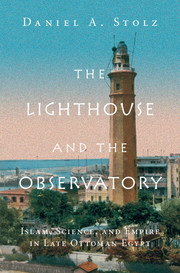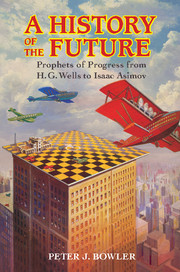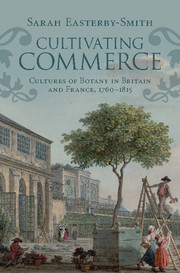Refine search
Actions for selected content:
13588 results in History of science and technology
Part I - Geographies of Knowledge
-
- Book:
- The Lighthouse and the Observatory
- Published online:
- 21 December 2017
- Print publication:
- 11 January 2018, pp 21-118
-
- Chapter
- Export citation
6 - The Measure of Piety: Making Prayer Times Uniform
- from Part III - Islam, Science, and Authority
-
- Book:
- The Lighthouse and the Observatory
- Published online:
- 21 December 2017
- Print publication:
- 11 January 2018, pp 207-242
-
- Chapter
- Export citation
Note on Chronology and Transliteration
-
- Book:
- The Lighthouse and the Observatory
- Published online:
- 21 December 2017
- Print publication:
- 11 January 2018, pp xiii-xiii
-
- Chapter
- Export citation
Conclusion: Astronomy, the State, and Islamic Authority at the End of the Day
-
- Book:
- The Lighthouse and the Observatory
- Published online:
- 21 December 2017
- Print publication:
- 11 January 2018, pp 271-278
-
- Chapter
- Export citation
Dedication
-
- Book:
- The Lighthouse and the Observatory
- Published online:
- 21 December 2017
- Print publication:
- 11 January 2018, pp v-vi
-
- Chapter
- Export citation
Introduction: Astronomy, Empire, and Islamic Authority at the End of Days
-
- Book:
- The Lighthouse and the Observatory
- Published online:
- 21 December 2017
- Print publication:
- 11 January 2018, pp 1-20
-
- Chapter
- Export citation
Acknowledgments
-
- Book:
- The Lighthouse and the Observatory
- Published online:
- 21 December 2017
- Print publication:
- 11 January 2018, pp xi-xii
-
- Chapter
- Export citation
7 - Different Standards: The Ramadan Debates and the Establishment of Lunar Crescent Observation
- from Part III - Islam, Science, and Authority
-
- Book:
- The Lighthouse and the Observatory
- Published online:
- 21 December 2017
- Print publication:
- 11 January 2018, pp 243-270
-
- Chapter
- Export citation
Index
-
- Book:
- The Lighthouse and the Observatory
- Published online:
- 21 December 2017
- Print publication:
- 11 January 2018, pp 307-316
-
- Chapter
- Export citation

The Lighthouse and the Observatory
- Islam, Science, and Empire in Late Ottoman Egypt
-
- Published online:
- 21 December 2017
- Print publication:
- 11 January 2018
The past as a work in progress
-
- Journal:
- The British Journal for the History of Science / Volume 51 / Issue 1 / March 2018
- Published online by Cambridge University Press:
- 20 December 2017, pp. 1-15
- Print publication:
- March 2018
-
- Article
-
- You have access
- HTML
- Export citation
Phyllis M. Tookey Kerridge and the science of audiometric standardization in Britain
-
- Journal:
- The British Journal for the History of Science / Volume 51 / Issue 1 / March 2018
- Published online by Cambridge University Press:
- 13 December 2017, pp. 123-146
- Print publication:
- March 2018
-
- Article
- Export citation
Disciplining Physiological Psychology: Cinematographs as Epistemic Devices in the Work of Henri Bergson and Charles Scott Sherrington
-
- Journal:
- Science in Context / Volume 30 / Issue 4 / December 2017
- Published online by Cambridge University Press:
- 08 February 2018, pp. 423-474
- Print publication:
- December 2017
-
- Article
-
- You have access
- Open access
- HTML
- Export citation
SIC volume 30 issue 4 Cover and Front matter
-
- Journal:
- Science in Context / Volume 30 / Issue 4 / December 2017
- Published online by Cambridge University Press:
- 08 February 2018, pp. f1-f3
- Print publication:
- December 2017
-
- Article
-
- You have access
- Export citation
Prestige Asymmetry in American Physics: Aspirations, Applications, and the Purloined Letter Effect
-
- Journal:
- Science in Context / Volume 30 / Issue 4 / December 2017
- Published online by Cambridge University Press:
- 08 February 2018, pp. 475-506
- Print publication:
- December 2017
-
- Article
- Export citation
Ruggiero Boscovich and “the Forces Existing in Nature”
-
- Journal:
- Science in Context / Volume 30 / Issue 4 / December 2017
- Published online by Cambridge University Press:
- 08 February 2018, pp. 385-422
- Print publication:
- December 2017
-
- Article
- Export citation
SIC volume 30 issue 4 Cover and Back matter
-
- Journal:
- Science in Context / Volume 30 / Issue 4 / December 2017
- Published online by Cambridge University Press:
- 08 February 2018, pp. b1-b4
- Print publication:
- December 2017
-
- Article
-
- You have access
- Export citation

A History of the Future
- Prophets of Progress from H. G. Wells to Isaac Asimov
-
- Published online:
- 27 November 2017
- Print publication:
- 02 November 2017

Cultivating Commerce
- Cultures of Botany in Britain and France, 1760–1815
-
- Published online:
- 27 November 2017
- Print publication:
- 09 November 2017
James Delbourgo , Collecting the World: The Life and Curiosity of Hans Sloane. London: Allen Lane, 2017. Pp. xxxi + 504. ISBN 978-1-84614-6572. £25.00 (hardback).
-
- Journal:
- The British Journal for the History of Science / Volume 50 / Issue 4 / December 2017
- Published online by Cambridge University Press:
- 17 November 2017, pp. 731-732
- Print publication:
- December 2017
-
- Article
- Export citation
